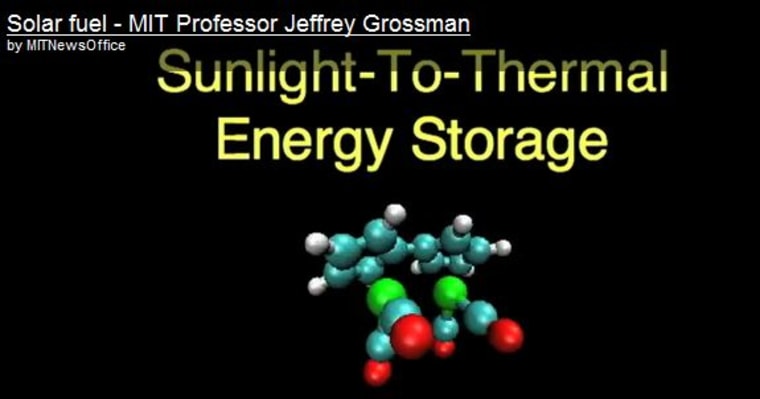If solar power had a sound bite, a tagline, a motto, it would be "use it or lose it."
That's because technologies designed to harness solar energy — for example, photovoltaics that capture photons or solar-thermal collectors that harvest heat — are not designed to store it. The sun comes out and the electricity is generated on the spot. Any extra sunlight (and there's a lot of it) spills over the edge like too much milk in a glass, forever wasted.
But don't cry. MIT's Jeffrey Grossman and his colleagues have done some initial research that could lead to an entirely new method for capturing and storing sunlight, and it has the potential to make this renewable energy indefinitely storable and transportable.
The research is based on the molecule fulvalene diruthenium, which is derived from the rare, expensive and platinum-like element, ruthenium.
Grossman and his team found that when a fulvalene diruthenium molecule absorbs sun, it changes shape into a semi-stable formation. Adding a catalyst to the mixture, snaps the molecule back into it original form.
This is very interesting from a solar energy perspective because the molecule can absorb sun and remain in the semi-stable state indefinitely until a catalyst snaps it back into its original form. When that last change occurs, energy is released that can be used to heat a home or power appliances.
Grossman thinks such a molecule could work in liquid form to convert and store solar power.
"There are probably a number of ways it could work at a systems level," Grossman wrote in an email to Discovery News.
"But one possible picture would be that the fuel could be placed out in the sun in deep pools, and throughout the day the fuel would get charged by the sunlight. Once charged it can be pumped and delivered (through pipes, or other means) to a point of use -- that could be nearby or far away," he said.
A fuel made from fulvalene diruthenium, “can get as hot as 200 degrees Celsius, plenty hot enough to heat your home, or even to run an engine to produce electricity," he told the MIT News Office.
The only problem, and it's a big one, is that the diruthenium molecule is expensive and so using it as a rechargeable liquid battery is not practical. But now that Grossman and his team understand the fundamental mechanism, they think they can find other, cheaper molecules that exhibit the same characteristics.
This video gives another explanation.
